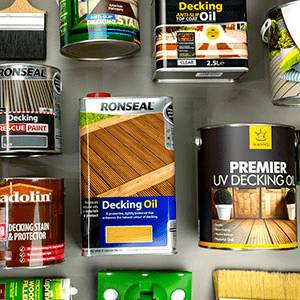Window Finish FAQ's
What wood filler can I use for a rotten window sill and frame?
Before filling any rotten areas, it's important to remove as much loose and rotten wood as possible. We recommend treating the affected area with Ronseal Wet Rot Wood Hardener first to stabilise and harden the damaged and immediately surrounding areas. Once treated and prepped, any rotten or damaged areas can be filled using Ronseal High Performance Wood Filler. Once this has set hard the repaired area should be sanded smooth ready for applying an exterior wood primer and paint.
What is the best wood filler for window frames?
This can depend on which part of the window frame is to be filled and what type of finish the window frame will be coated with once repaired. Some wood fillers are only suitable for interior use while others are formulated for exterior use. If the window frame is to be painted after repair it doesn't matter if you use a filler that has a solid opaque colour as it will be covered by the paint. If the window is being treated with a semi-translucent coating system such as Sikkens or Sadolin, you'll need the repaired area to look more like wood so we recommend Fiddes Wood Filler Gel. These types of filler are mixed with sanding dust, (it is preferable to use dust from the wood that is to be filled which helps to produce a better colour match), to produce a wood filler paste that is essentially half made of wood and therefore will absorb the wood finishing product in a more similar way to the wood surrounding it. Once coated with a semi-translucent finish, the repaired area will be less visible than with a standard opaque wood filler.
See our full range of fillers suitable for windows, frames and sills.
What filler can I use to seal gaps between window frames and walls?
There are several flexible wood fillers that are ideal for sealing small gaps between window frames and walls. Bona Gap Master comes in a range of colours and is ideal for sealing interior gaps between window frames and walls. Cuprinol All Purpose Wood Filler, also available in several colours can be used for both interior and exterior gaps.
Advice needed on which window stain to use?
Although there are many coloured exterior varnishes, 2 brands that are considered by many to be the best in the market are Sadolin and Sikkens. These stain systems offer excellent durability by combining a base stain with a matching colour top coat. These top coats have a wear layer that can be easily maintained by re-coating when it starts to lose it's sheen or weatherproofing properties.
This products are ideal for all soft and hardwood timbers although some exotic hardwoods such as Teak and Iroko require more careful preparation prior to staining.
What is the best wood preservative for window frames?
Most exterior wood preservatives will do the trick with a wide range of clear and colour options to consider. A few popular options are Ronseal Total Wood Preservative and Barrettine Premier Wood Preserver. Both of these products are solvent-based and contain a small amount of wax. If a water-based option is preferred, consider Cuprinol Ultimate Garden Wood Preserver which is a low VOC, water-based formulation.
If painting the frames with a water-based paint or varnish, it's important to use a wax-free preserver, such as Barrettine Premier Universal Preserver before painting for maximum possible compatibility.
I use Osmo Oil 420, but note that it is not recommended for horizontal surfaces. Can you advise what product I should use for window sills which are, of course, horizontal & do seem to need more regular treatment than the rest of the window?
It is true that Osmo 420 will not last as long on a horizontal surface and is not recommended by Osmo. It can be used if the sills have enough of an angle to allow any water to run off. Even if the sills have a suitable run off angle, they will still likely require more maintenance than vertical surfaces.
The issue with horizontal surfaces is that water pools on the surface of the finish / wood. Being microporous, if the standing water or moisture doesn't dry for a prolonged period, it can eventually penetrate through the finish and into the wood. This can cause issues for both the finish and the wood including the potential for mould, swelling and warping of the timber.
An alternative to using an oil is to use a coating-based system from brands such as Sikkens or Sadolin. These brands produce coating systems where a base-coat or colour is applied then over-coated with a highly durable top-coat. The benefit of these products is that they are more resistant to standing water and will require less maintenance than oils on a horizontal surface. This said, the top-coat will degrade over time and will require maintenance at some point to retain the protective properties of the finish.
To discuss the various products and options in more detail, we recommend that you contact us and speak with one of our resident wood care experts.
Can Ronseal 10 year Weatherproof paint be used over windows previously treated with an unknown oil based paint? If you can you recommend any preparation step to achieve longest lasting results (will coating them first with Ronseal Super Flexible Primer and Undercoat help?) I only ask because I have heard that water-based paints shouldn't be used over oil. I would appreciate your advice.
Ronseal 10 Year Weatherproof Wood Paint is water-based and therefore cannot be used over an oil based finish, even if it is old and worn as it may not effectively bond to the surface of the oil-based paint. Potential issues include poor adhesion, reduced protection, colour variance and more. The best approach will be to remove the old paint by sanding or with a paint stripper, taking the surface back to clean, bare wood. This will provide the best surface for painting and will ensure any longevity guarantee stipulated by the paint manufacturer i.e. '10 years'.
Once stripped back to bare wood, cleaning the wood by wiping down with Methylated spirit can aid adhesion of any paint or primer used.
We have 10 year old double glazed wooden windows - white externally and sealed timber internally . The internal frames need sanding to get rid of black mould etc and I then to varnish/ reveal with something reasonably fast drying. Preferably satin or Matt finish. Which product would fit my needs? Thanks.
Once sanded down, we recommend using Barrettine Mould and Mildew Cleaner. This will not only clean the mould from the wood but will also kill off any living mould spores deeper in the wood grain, therefore helping to prevent mould from growing back shortly after re-finishing.
Sikkens Cetol TSI Satin Plus is a great option for interior wooden sills and frames. This is a coloured varnish that will give a long lasting protective finish. The product is UV resistant so will protect the colour of the wood for longer, and dries to a satin finish.
For a clear option, consider Manns Extra Tough Interior Varnish. This tough, durable interior varnish is water-based and is available in a range of sheen levels. It's also available in sample sizes.
I think to remember talk about a Liberon product especially for outdoor Oak applications. In my case I need to find a clear UV Stable and preferable an Oil that can be used on my new Oak Windows, Sills and Doors, that will be exposed to heavy rain and strong sunlight. What can you recommend?
It's worth mentioning that exterior Oak can be problematic as it has a tendency to split and crack fairly quickly once exposed to the elements. Another point worth mentioning is that oils tend to weather quicker on horizontal surfaces where moisture or water can sit for prolonged periods. They can be used but depending on where the property is situated and the amount of weathering it receives, may need semi-regular maintenance to retain the integrity and effectiveness of the finish. This is less of an issue if the window sills have an angled surface so that water runs off rather than pooling on the surface. In terms of exterior joinery there are a couple of options you could consider. These are...
Both of these products are durable and contain UV filters to slow down the greying process caused by the suns UV rays. These penetrating wood oils are water / moisture repellent and help to keep the wood nourished and supple, therefore reducing the chances of the wood drying out and warping.
In terms of UV resistance, a coloured product always provides better UV protection than a clear product. This is because the colour pigments within the product essentially help to block some of the UV rays from reaching the wood.
A product that can be used to improve water resistance prior to applying the Osmo oil above is Osmo WR Base Coat (4001). This is a protective base-coat that can be used with most of the oils in the 'UV protection oil extra' range. This product however is not recommended for use as a basecoat under Osmo UV Protection Oil Natural (429).
An alternative approach to using a wood oil and possibly a better option for Oak would be to use a coating-based system from brands such as Sikkens or Sadolin. These brands produce coating systems where a base-coat or colour is applied then over-coated with a highly durable top-coat. The benefit of these products is that they are more resistant to standing water and will require less maintenance than oils on a horizontal surface. This said, the top-coat will degrade over time and will require maintenance at some point to retain the protective properties of the finish.
To discuss the various products and options in more detail, we recommend that you contact us and speak with one of our resident wood care experts.
I have a wood framed skylight in a bedroom. It's at a 45 degree angle in the ceiling. It gets covered with condensation. The wood frame has lost its varnish and is very wet. There's no rot as yet but the surface feels a little soft and is getting discoloured/ blackish in places, with mould presumably in and below the surface. I guess I can't varnish it now because of the wet and mould, but what can I do to get rid of the mould and dry and harden it prior to varnishing? It will be a struggle with a nightly dose of fresh condensation to contend with.
Ideally, the issue of condensation needs addressing first so that the wood can dry out fully. There are likely to be issues with any wood finish that is applied to wet wood or wood that has a high moisture content. This project is better left until spring or summer when a spell of warm, dry weather is forecast and the window can be left open for a couple of days to a week to fully dry out. Once dry, treatment can begin.
Once dry, any existing varnish must be removed by sanding or with a paint stripper or remover. When the old varnish has been removed and the bare wood is exposed, treat the wood with a mould and mildew cleaner such as Barrettine Mould and Mildew Spray. This will remove the blackening of the wood and kill off any mould spores in the surface of the wood. If the blackening is particularly bad, a second application of the mould and mildew cleaner may be required.
If the wood has softened, it can be treated with Ronseal Wet Rot Wood Hardener to restore the strength and integrity of the timber. Once this has fully dried, treat the wood with a suitable wood preserver. Our recommendation would be to use a wax-free wood preservative such as Barrettine Premier Universal Preserver. This will help to prevent further issues with mould and algae. Being a 'wax-free' preservative it's also fine to use prior to re-varnishing or painting the wood with a water-based product. If moisture is an on-going problem, an interior wood oil such as a hard wax oil could be a better option. Hard Wax Oils will never crack, flake or peel, are extremely water resistant and are very easy to apply and maintain.
Key to the long term success of this project however is trying to resolve the condensation issue. If you have any further questions or queries regarding this project or any of the products suggested above, feel free to contact us.
Can you recommend a good exterior wooden window paint?
We have a number of wood paints suitable for exterior windows, frames and sills, one of these is Ronseal 10 Year Weatherproof Wood Paint - Gloss. Available in a range of colours including pure brilliant white and black, this weatherproof wood paint offers up to 10 years wood protection. If a satin finish is preferred, consider Ronseal 10 Year Weatherproof Wood Paint - Satin..
As with all wood finishing products, the key to a long-lasting finish is in the preparation and the application of the product.
Disclaimer: Whilst every attempt has been made to provide product information that is as accurate as possible, it's important to clarify that trees and the wood that they produce can be affected by many factors. For example, the same species of tree grown in the same wood, even in close proximity, will be affected by age along with the amount of sunlight and water they receive. Other naturally occurring biological and environmental factors will also influence the density and grain of the wood as well as the moisture and oil content of the timber. No two trees are the same, meaning each piece of wood has the potential to look and react differently to the same wood finish. For example, product adhesion, colour variations, absorption rates and sheen levels. It is for this reason that we always strongly recommend carrying out test areas before starting any project


